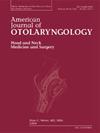舌腭瓣软骨植入扩张括约肌咽成形术治疗阻塞性睡眠呼吸暂停
IF 1.8
4区 医学
Q2 OTORHINOLARYNGOLOGY
引用次数: 0
摘要
背景:咽鼓腭咽成形术及其改良,包括扩张括约肌咽成形术,是阻塞性睡眠呼吸暂停最常见的手术干预措施。目的介绍一种扩张括约肌咽成形术并在上颚植入软骨的新手术方法。方法选择需要鼻中隔成形术和咽成形术的成人患者。在干预组,扩张括约肌咽成形术,从他们的鼻中隔获得软骨植入到舌腭瓣部位。对照组除插入软骨外,均行类似手术。术后第3、6个月采用STOP-Bang问卷(SBQ)、Epworth嗜睡量表(ESS)和打鼾水平评估手术效果。结果共纳入31例,平均年龄36.9±9.0岁,男性27例(87.1%)。干预组(n = 16)随访时,SBQ从3.94±1.39降至2.33±1.11和1.80±1.21 (p <;0.001), ESS从10.31±5.52降至5.20±2.83和3.33±1.76 (p <;0.001),打鼾水平由2降至1和1 (p <;0.001)。对照组(n = 15) SBQ由4.23±0.60降至2.38±0.96和2.08±1.11 (p <;0.001), ESS从13.08±5.88降至7.69±4.27和5.69±4.05 (p <;0.001),打鼾水平从3级降至2级和1级(p <;0.001)。组间比较显示,第二次随访时ESS为边缘性(p = 0.051),第一次和第二次随访时打鼾水平差异有统计学意义(p = 0.019)。结论对部分患者行软骨植入扩张括约肌咽成形术可提高手术效果。本文章由计算机程序翻译,如有差异,请以英文原文为准。
Expansion sphincter pharyngoplasty with cartilage implant in uvulopalatal flap for treatment of obstructive sleep apnea
Background
Uvulopalatopharyngoplasty and its modifications, including expansion sphincter pharyngoplasty, are the most common surgical interventions for obstructive sleep apnea.
Objective
To introduce a novel surgery technique in which expansion sphincter pharyngoplasty was performed accompanied by inserting a cartilage implant into the palate.
Methods
Adult patients required septoplasty and pharyngoplasty were selected. In intervention group, expansion sphincter pharyngoplasty was performed with the insertion of a cartilage implant, obtained from their septum into the uvulopalatal flap site. In control group, similar procedures were performed except for cartilage insertion. Surgery outcome was assessed at the 3rd and 6th month post-operation by STOP-Bang Questionnaire (SBQ), Epworth Sleepiness Scale (ESS), and snoring level.
Results
Thirty-one individuals with a mean age of 36.9 ± 9.0 years, consisting of 27 (87.1 %) men, were recruited. At follow-ups sessions of intervention group (n = 16), the SBQ decreased from 3.94 ± 1.39 to 2.33 ± 1.11 and 1.80 ± 1.21 (p < 0.001), ESS decreased from 10.31 ± 5.52 to 5.20 ± 2.83 and 3.33 ± 1.76 (p < 0.001), and snoring level decreased from 2 to 1 and 1 (p < 0.001). In control group (n = 15), the SBQ decreased from 4.23 ± 0.60 to 2.38 ± 0.96 and 2.08 ± 1.11 (p < 0.001), ESS decreased from 13.08 ± 5.88 to 7.69 ± 4.27 and 5.69 ± 4.05 (p < 0.001), and snoring level decreased from 3 to 2 and 1 (p < 0.001). Between group comparison indicated that ESS was marginal at the second follow-up (p = 0.051), and the snoring level was significantly different at first (p = 0.019) and second (p = 0.031) follow-ups.
Conclusion
Performing expansion sphincter pharyngoplasty with a cartilage implant in selected individuals improved surgery outcome.
求助全文
通过发布文献求助,成功后即可免费获取论文全文。
去求助
来源期刊

American Journal of Otolaryngology
医学-耳鼻喉科学
CiteScore
4.40
自引率
4.00%
发文量
378
审稿时长
41 days
期刊介绍:
Be fully informed about developments in otology, neurotology, audiology, rhinology, allergy, laryngology, speech science, bronchoesophagology, facial plastic surgery, and head and neck surgery. Featured sections include original contributions, grand rounds, current reviews, case reports and socioeconomics.
 求助内容:
求助内容: 应助结果提醒方式:
应助结果提醒方式:


